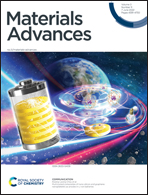Electrocatalytic CO2 reduction reaction on dual-metal- and nitrogen-doped graphene: coordination environment effect of active sites†
Abstract
Electrochemical CO2 reduction reaction (CO2RR) is a promising method to convert CO2 to CO, and developing CO2RR electrocatalysts is essential to improve the conversion efficiency. Herein, the CO2RR catalytic performance of dual-metal–nitrogen–carbon catalysts (M1/M2–N6–Gra, Model 1, Model 2, and Model 3) with different bimetals and different coordination environments at active sites (the coordination number of metal and nitrogen ranges from 2 to 4) has been systematically studied through density functional theory (DFT). The calculated formation energies indicate that high-coordinated catalysts are thermodynamically stable. By calculating the Gibbs free energy changes of the CO2RR pathway and the selectivity of hydrogen evolution reaction (HER), we determine that the coordination environment of the active sites of the catalysts strongly affects the activity and selectivity of CO2 reduction to CO. The low-coordinated catalysts have strong *COOH and *CO adsorption capacity, and it is difficult for CO to desorb from the catalyst surface, resulting in the poor catalytic activity of CO2RR; the high-coordinated catalysts have moderate *COOH and *CO adsorption capacity, and have excellent catalytic activity for reducing CO2 to CO. In addition, the CO2RR reduction activity of most heteronuclear M1/M2–N6–Gra has been enhanced due to the synergy between heterometallic metals, and the synergy is effectively improved with the increase of the coordination number. In particular, using the limiting potential difference of CO2RR and HER as the selective descriptor, we have screened out four catalysts, including Co/Zn, Fe/Zn, Mn/Zn, and Fe/Mn–N6–Gra-Model 3 (the coordination number of metal and nitrogen is 4), which have favorable limiting potentials of −0.20, −0.24, −0.26, and −0.26 V, respectively. This work provides guidance for the development of effective bimetallic single-atom catalysts based on nitrogen-doped carbon materials for CO2RR.



 Please wait while we load your content...
Please wait while we load your content...